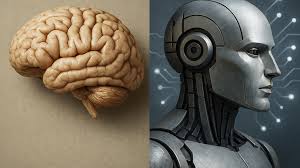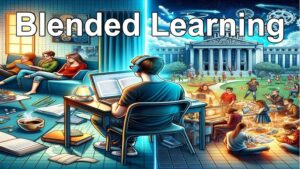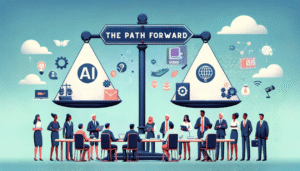
In an age where artificial intelligence and automation adeptly take on numerous traditional tasks, a significant question arises: Should schools continue to prioritize foundational instructional skills, such as cursive writing, multiplication tables, and spelling?  The conversation is often framed as a binary choice: either we uphold outdated practices or fully embrace a digital-first approach. However, this dichotomy oversimplifies the issue. Foundational skills are not merely relics of the past; they are essential building blocks for cognitive development and digital fluency. I contend that foundational skills in math and literacy form the necessary scaffolding for advanced competencies, such as coding, digital problem-solving, and critical media literacy. My observation is that students who excel in math and reading tend to perform exceptionally well in coding and navigating technology.
The conversation is often framed as a binary choice: either we uphold outdated practices or fully embrace a digital-first approach. However, this dichotomy oversimplifies the issue. Foundational skills are not merely relics of the past; they are essential building blocks for cognitive development and digital fluency. I contend that foundational skills in math and literacy form the necessary scaffolding for advanced competencies, such as coding, digital problem-solving, and critical media literacy. My observation is that students who excel in math and reading tend to perform exceptionally well in coding and navigating technology.
During the debate, both teams highlighted key tensions in contemporary pedagogy. Brianne and Rose argued that teaching cursive writing is increasingly obsolete in an era where digital tools dominate communication. They advocated reallocating time to more “relevant” skills like keyboarding and coding, aligning with broader curricular reforms aimed at modernizing education.

However, this perspective narrowly frames education as a utilitarian process, ignoring the cognitive and neurological benefits of foundational skills. Vanessa and Jenna presented a holistic view grounded in research from the National Education Association (NEA), arguing that cursive writing promotes memory retention, fine motor coordination, and brain activation that typing does not engage—all factors that I can attest to. According to Betty Blog (2024), handwriting activates more brain regions and connections when compared to typewriting. Instruction should therefore be designed to support the whole learner, not just job-ready competencies.
Research supports the argument that foundational literacy and numeracy significantly contribute to students’ overall academic cognitive development. According to an article in the Calgary Sun (2014), Alberta’s educational outcomes suffered when curricula neglected basic math skills in Favour of conceptual understanding. Parents and educators reported that students were unable to perform simple calculations without technological assistance, leading to widespread concerns over “math illiteracy” (Leong, 2014). This example illustrates the dangers of prematurely abandoning foundational skills in the name of innovation.
Similarly, a report from LatinHire (2024) stresses the importance of math fluency as a prerequisite for more complex cognitive tasks, including programming and data analysis. It identifies five compelling reasons why students must develop math foundations, including problem solving, logical thinking, and the ability to connect abstract concepts to real-world applications. These skills not only support traditional academic success but also underpin competencies required for STEM and digital fields (“5 reasons Why Kids Need Math,”2024).
Bridging the Gap

Students thrive when foundational and digital skills are taught in tandem, rather than in isolation. My stance is shaped by both educational research and classroom experience: when students master foundational reading and math skills, they are better equipped to excel in digital literacy and computer science. Coding, for example, requires logical sequencing, pattern recognition, and comprehension, abilities rooted in traditional curricula. Moreover, spelling and vocabulary enhance algorithmic thinking and language syntax comprehension, directly benefiting students learning programming languages.
The belief that school is “boring and irrelevant,” as reported in a Telegraph article surveying teenagers (2009), is often a result of disconnected and outdated instruction, not the content itself. The challenge, then, is not to discard cursive or multiplication tables, but to reimagine their delivery in a way that links them to students lived realities and future aspirations.
For example, in one documented case at an elementary school in British Columbia, teachers using MindUP reported a significant increase in student engagement and motivation, as students better understood how their classroom learning connected to personal goals and community involvement (Schonert-Reichl et al., 2015). MindUP is a program developed by The Goldie Hawn Foundation. This program integrates neuroscience, social-emotional learning, and mindful awareness into core subjects like math and literacy. Blended learning models and project-based instruction can anchor traditional skills within meaningful, technology-enhanced contexts.
The Move Toward Integration

The current educational landscape demands a nuanced approach, one that values both tradition and innovation. Foundational skills such as cursive writing, spelling, and multiplication tables serve cognitive, neurological, and academic purposes that extend far beyond their surface utility. When students develop these skills, they are better prepared to transition to complex, technology-dependent competencies. Rather than choosing between teaching cursive or coding, schools should embrace an integrated literacy framework that balances analog and digital literacies under clear, intentional policies.
Educators, parents, and policymakers must recognize that foundational learning is not a barrier to progress; it is the launchpad. Ensuring that all students have access to both sets of skills will foster more equitable, empowered, and future-ready learners.


Dear Sadi,
Thank you for your thoughtful, informative, and wonderfully argued post. I particularly like the way you counter the argument that cursive, multiplication tables and solid spelling (the article doesn’t use the term but by inference I mean more than just sound it out) are not needed in this world. This is an argument I have heard and must admit have had myself, particularly in relation to cursive writing. You make such a strong case as to why these activities are needed for the development of digital fluency, based on research and of course logic that they are not extra-curricular, but more like pre-curricular, which I agree with.
Two examples of your comment jumped out for me, “neurologically handwriting is great for brain development, “and” solid maths and literacy are the cornerstone for coding success.” In an era of keyboard and screen these seemed like great statements as to why foundational knowledge and skill will be the cornerstone for innovation. I was interested to read the explanation of MindUP and how it dovetails into a way forward in Alberta in which they are jettisoning so much. It was again reassuring to read that Alberta is looking at ways to integrate, not replace skills which again it appears I was jumping to conclusions in terms of my province.
You ended your post with such an empowering statement and I agree completely that the way forward is making sure we are teaching with purpose. In our daily grind of teaching it is so easy to get disconnected from the larger picture and one needs to pause and ask, how are we going to support these students in the here and now, and in their future life? Thank you for the wonderful post, for the ideas and resources and for leading this important dialogue for us.
Nofisat
Sadi,
Reading these reminded me of teaching students in the past who became so easily frustrated and shut down because they were using so much of their brain power with the simpler steps of a math equation or reading of a sentence. Building that fluency is essential, and you’re right: “Foundational skills are not merely relics of the past; they are essential building blocks for cognitive development and digital fluency.” Even when I think of this in terms of learning an instrument… music students will never get to the point where they are able to play fluently and with feeling if they don’t have those notes down pat.
I guess my thought is, can we still emphasize the importance of fluency while giving students a strategy to use when their memory fails them? Combining the strategy with practice and building fluency seems to be worth the time and the effort on the part of teachers.
Thanks for sharing 🙂
Sadi, I enjoy your metaphor with the launch pad. Students need all the skills before they can successfully take off and navigate in the 21st century. I agree with the idea of blended learning, “you can’t have one without the other…”, there needs to be a tandem. This blending of old & new relies on a ‘whole-child’ approach to teaching and learning.
Hi Sadi,
You present several compelling arguments. I agree that foundational skills such as spelling, and multiplication are building blocks of digital fluency. The comment regarding the importance of supporting the development of the whole learner, rather than focusing solely on job readiness, is significant. Preparing children to become employable adults is important, but it represents only one aspect of their overall development.
I agree that it is the instruction, not the content, that needs to be reimagined and updated. Your post presented some great arguments. Thank you for contributing your insights.
Jenna
Hi Sadi!
Thank you for your well-articulated ideas! Your writing flows seamlessly from one point to the next! One idea that stood out to me is when you mentioned that foundational learning skills are not barriers to progress, but are instead a launch pad. I think this is an excellent way to word it, as I, too, believe that these foundational skills do not need to be replaced. Foundational skills can instead be enhanced by technology to suit the needs of our current students. I also agree that everything has a time and place, and this is a topic where we can’t have an all-in or nothing approach. In your classroom, are there ways that you have integrated technology to aid in teaching these foundational skills? Do you have students who practice skills such as coding? I have not tried coding yet in my classroom, but it is something I have thought about doing in one of our science units. Thanks for a great post!